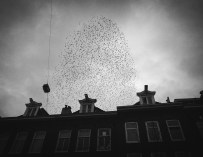Hyperfocal Distance vs Merklinger – who’s right?
Speed is pretty important in street photography. I’m working with a tool that’s the fastest for me: a rangefinder camera. I set the exposure time and f-stop beforehand matching the light, going for maximum depth of field at 1/250 or above. Depending on the scene I see building in front of me I basically switch focus between three settings: close, medium far or maximum detail from front to back.
 Focussed at infinity to have maximum details from front to back
Focussed at infinity to have maximum details from front to back
Did you just ask yourself: “Infinity? Did he mix it up with hyperfocal?” To answer your question, I’ll tell you a little story.
I’m using a digital full frame rangefinder and a rather old lens, a Summicron 35 built in the 70s. When I realized that the pictures in “hyperfocal mode” were not – as expected – sharp at infinity, I thought it was because of that old working horse getting tired.

1:1 crop, hyperfocal set for f/11: not even sharp in the middle distance
I actually thought about getting a brand new Summicron since I suspected it was just my beaten lens. When I tested the current model, the Summicron 35 ASPH, I was pretty confused seeing the exact same result. OK, better sharpness, less contrast and different color rendering, but again no sharp spot at infinity. I switched my M9 for a brand new M240 to be totally sure – it seemed to be the normal behavior. I played around with different settings and realized that I pretty much saw the results I was hoping for in one case: when setting the focus to infinity.

1:1 crop, focus at infinity – sharp from middle distance to the far background
So what’s wrong with the concept of hyperfocal? Turns out it’s just not applicable to modern camera equipment. I stumbled upon the book “The Ins And Outs Of Focus” by Harold Merklinger. He describes how the hyperfocal distance is calculated based on the assumption of film and lenses that have a much lower resolution than the ones he uses.
”[…] films today are capable of much, much better resolution than one-twentieth or one-thirtieth of a millimeter. A good number to use for the best films today is more like one-two-hundredth of a millimeter.” (Merklinger: The ins and outs of focus, 1990, p. 13)
So that was in the 90s – how does this apply to modern digital cameras? Here are the example pictures I took the 1:1 crops above from. You can click on them to open the full size image and see for yourself. I’ll explain the important details below them.

Hyperfocal

Infinity
So we saw the farer away parts above being sharp when focussing infinity, but what about the foreground? Is it all unsharp just like the background was in the first example of hyperfocal?

Hyperfocal

Infinity
We lose some detail here, factor 2 according to Merklinger. If you look at the full size picture you won’t really see the difference, but that’s the trade off for getting factor six more resolution in the medium distance and background:

Hyperfocal

Infinity
“In practice, by focusing instead at infinity, we will lose a factor of two in subject resolution at the near limit of depth-of-field but gain about a factor of six in the resolution of distant subjects! It’s often worth the trade.” (Merklinger: The ins and outs of focus, 1990, p. 32)
So the answer if you have to bother or not is: it depends on the subject and the size of your prints. If you’re having layout prints it won’t make too much of a difference. If you go 20x30cm and over the effect will be more and more visible. I’m currently using the Merklinger technique for subjects that are close and where I want to have the background sharp, like the initial picture. The classical use case for hyperfocal. If you look at it 1:1 then you’ll see that the sharpness of the subjects in the front is lower than the sharpness of the background. If you judge it by the level of details, you achieve the impression of overall sharpness since the objects and subjects in the back are smaller than those in the front. I switched from hyperfocal to this technique completely. The following picture – which I’m not too sure about if it’s a keeper – is an example for using focussing at infinity, or Merklinger focus if you like:

Hamburg, 2014 (License: CC BY-SA Sven Kräuter, arebureboke.com)
I’m not sure if this effect appears using smaller sensors too. I’m pretty sure it’s the same effect when using film. I’m actually exploring the behaviour currently & can keep you posted if you’re interested. In the meantime I’d be more than interested about your opinion on this technique that I find totally handy.









Related Articles